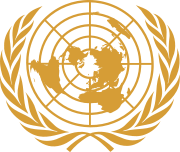Secretary-General of the United Nations
|
||||||||||||||||
The Secretary-General of the United Nations is the head of the Secretariat, one of the principal organs of the United Nations. The Secretary-General also acts as the de facto spokesperson and leader of the United Nations.
The current Secretary-General is Ban Ki-moon of South Korea, who took office on 1 January 2007. His first term will expire on the 31st of December 2011, and he will be eligible for reappointment.
Contents |
Role
The Secretary-General was envisioned by US President Franklin D. Roosevelt as a "world moderator," but the office was defined in the UN Charter as the organization's "chief administrative officer" (Article 97). Nevertheless, this more restricted description has not prevented the office holders from speaking out and playing important roles on global issues, to various degrees.
The official residence of the Secretary-General is a five-story townhouse in the Sutton Place neighborhood of Manhattan in New York City, New York, United States. The townhouse was built for Anne Morgan in 1921, and donated to the United Nations in 1972.[1]
Term and selection
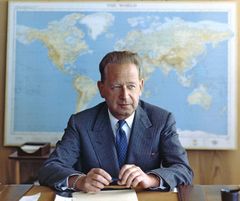
Secretaries-General serve for five-year terms that can be renewed indefinitely, although none so far has held office for more than two terms;[2] most have served two terms. The Charter provides for the Secretary-General to be appointed by the General Assembly upon the nomination of the Security Council. Therefore, the selection is subject to the veto of any of the five permanent members of the Security Council.
The UN Charter's terse language has since been supplemented by other procedural rules and also accepted practices. In practice, the Secretary-General cannot be a national of any of the Permanent Members of the Security Council. An accepted practice of regional (continental) rotation has also been adopted in the selection of successive candidates. The ability of candidates to converse in both English and French is also considered an unofficial qualification for the office.
Most Secretaries-General are compromise-candidates from middle powers and with little prior fame. High-profile candidates are often touted for the job, but are almost always rejected as unpalatable to some. For instance, figures like Charles de Gaulle, Dwight Eisenhower, and Sir Anthony Eden were considered for the first Secretary-General position, but were rejected in favor of the uncontroversial Norwegian Trygve Lie. Due to international politics and the mechanicisms of political compromise, there are many similarities between the process and ideals for selecting the Secretary-General and those of selecting leading figures in other international organizations, such as the election of Popes in the Roman Catholic Church, or the Premier of the former Soviet Union. Dag Hammarskjöld remains the only Secretary-General to have died in office.
In the early 1960s, Soviet ruler Nikita Khrushchev led an effort to abolish the Secretary-General position. The numerical superiority of the Western powers combined with the one state, one vote system meant that the Secretary-General would come from one of them, and would typically be sympathetic towards the West. Khrushchev advanced a proposal to replace the Secretary-General with a three-person leading council (a "troika"): one member from the West, one from the Communist states, and one from the Non-Aligned powers. This idea failed because the neutral powers failed to back the Soviet proposal.
Secretaries-General
Note: Alger Hiss was Secretary-General of the United Nations Conference on International Organization, held in April to June 1945.
| # | Portrait | Secretary-General | Dates in office | Country of origin | Reason of withdrawal | Ref. |
|---|---|---|---|---|---|---|
| – |  |
Gladwyn Jebb | 24 October 1945 – 1 February 1946 |
Served as Acting Secretary-General until Lie's election | ||
| After World War II, he served as Executive Secretary of the Preparatory Commission of the United Nations in August 1945, being appointed Acting United Nations Secretary-General from October 1945 to February 1946 until the appointment of the first Secretary-General Trygve Lie.[3] | ||||||
| 1 |  |
Trygve Lie | 1 February 1946 – 10 November 1952 |
Resigned | [4] | |
| Lie, a foreign minister and former labor leader, was recommended by the Soviet Union to fill the post. After the UN involvement in the Korean War, the Soviet Union vetoed Lie's reappointment in 1951. The US circumvented the Soviet Union's veto and recommended reappointment directly to the General Assembly. Lie was reappointed by a vote of forty-six to five, with eight abstentions. The Soviet Union remained hostile to Lie, and he resigned in 1952.[5] | ||||||
| 2 | Dag Hammarskjöld | 10 April 1953 – 18 September 1961 |
Died in a plane crash in Northern Rhodesia (now Zambia), while on a peacekeeping mission to the Congo | [6] | ||
| After a series of candidates were vetoed, Hammarskjöld emerged as an option that was acceptable to the Security Council. Hammarskjöld was re-elected unanimously to a second term in 1957. The Soviet Union was angered by Hammarskjöld's leadership of the UN during the Congo Crisis, and suggested that the position of Secretary-General be replaced by a troika, or three-man executive. Facing great opposition from the Western nations, the Soviet Union gave up on its suggestion. Hammarskjöld was killed in a plane crash in Northern Rhodesia (now Zambia) in 1961.[5] US President John F. Kennedy called Hammarskjöld "the greatest statesman of our century."[7] | ||||||
| 3 | 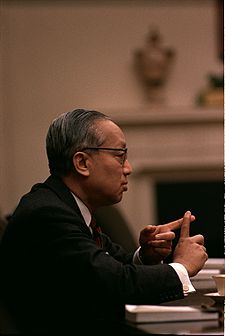 |
U Thant |
30 November 1961 – 31 December 1971 |
Declined to be considered for another term. | [8] | |
| In the process of replacing Hammarskjöld, the developing world insisted on a non-European and non-American. U Thant was nominated. However, due to opposition from the French (Thant had chaired a committee on Algerian independence) and the Arabs (Burma was supporting Israel), Thant was only appointed for the remainder of Hammarskjöld's term. Thant was the first Asian Secretary General. The following year, Thant was unanimously re-elected to a full five-year term. He was similarly re-elected in 1966. Thant did not seek a third term.[5] | ||||||
| 4 |  |
Kurt Waldheim | 1 January 1972 – 31 December 1981 |
China vetoed his third term. | [9] | |
| Waldheim launched a discreet but effective campaign to become the Secretary-General. Despite initial vetoes from China and the United Kingdom, in the third round Waldheim was selected to become the new Secretary-General. In 1976, China initially blocked Waldheim's re-election, but it relented on the second ballot. In 1981, Waldheim's re-election for a third term was blocked by China, which vetoed his selection through 15 rounds. In the mid 1980s, it was revealed that a post-WW II UN War Crimes Commission had labeled Waldheim as a suspected war criminal – based on his forced involvement with the Nazi German army. The files had been stored in the UN archive.[5] | ||||||
| 5 | Javier Pérez de Cuéllar | 1 January 1982 – 31 December 1991 |
Refused to be considered for a third term. | [10] | ||
| Pérez de Cuéllar was selected after a five-week deadlock between the re-election of Waldheim and China's candidate, Salim Ahmed Salim of Tanzania. Pérez de Cuéllar, a Peruvian diplomat, was a compromise candidate, and the first Secretary General from Latin America. He was re-elected unanimously in 1986.[5] | ||||||
| 6 | 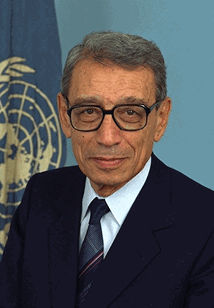 |
Boutros Boutros-Ghali |
1 January 1992 – 31 December 1996 |
The United States vetoed his second term. | [11] | |
| The 102 member Non-Aligned Movement insisted that the next Secretary-General come from Africa. With a majority in the General Assembly and the support of China, the Non-Aligned Movement had the votes necessary to block any unfavourable candidate. The Security Council conducted five anonymous straw polls – a first for the council. Boutros-Ghali emerged with 11 votes on the fifth round. In 1996 the US vetoed the re-appointment of Boutros-Ghali, claiming he had failed in implementing necessary reforms to the UN. Boutros-Ghali responded saying he was given insufficient resources caused in large part by countries with large debts owed to the UN, such as the US[5] On his watch the UN suffered two of the worst humiliations in its history, the massacre of almost a million people in the 1994 Rwanda genocide, under the impotent eye of a UN mission, and the genocide in 1995 of tens of thousands of Bosniaks (Muslims) in UN safe zones, including Srebrenica, in the former Yugoslavia, creating the phrase "ethnic cleansing". In both cases the UN judged itself to be at fault.[12] | ||||||
| 7 | 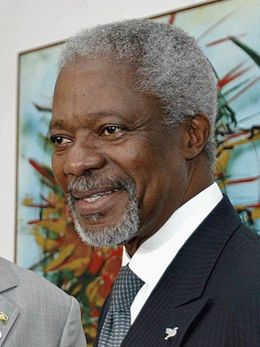 |
Kofi Annan | 1 January 1997 – 31 December 2006 |
Retired after two full terms | [13] | |
| Annan was head of the UN Department of Peacekeeping Operations before being selected as the Secretary-General. In 2001, after implementing changes such as a more fiscally responsible budget, Annan was unanimously re-elected to a second term.[5] Mr. Annan, an African, was also selected in an informal "rotation between continents" because Mr. Boutros-Ghali had only served for one term in the office. | ||||||
| 8 |  |
Ban Ki-moon | 1 January 2007– present |
Incumbent | [14]. | |
| Ban became the second Asian to be selected as the Secretary-General. The rotation among continents skipped North America for several reasons: a candidate from the United States is looked on unfavorably by many nations, there are few countries in North America to choose from, and Canada and Mexico had not put forward a favoured candidate for the role. | ||||||
| UN Regional Group | Secretaries-General | Terms |
|---|---|---|
| Western European and Others | 4 | 7 |
| Eastern European Group | 0 | 0 |
| Latin American and Caribbean Group | 1 | 2 |
| Asian Group | 2 | 3 |
| African Group | 2 | 3 |
See also
- United Nations Deputy Secretary-General
- List of Secretaries-General of the United Nations by longevity
- Global democracy
- International Court of Justice
- League of Nations
- Mundialization
- Presidential election
- Reform of the United Nations
- UN Economic and Social Council
- UN General Assembly
- UN Secretariat
- UN Security Council
- UN Trusteeship Council
- Under-Secretary-General of the United Nations
- United Nations System
- World government
References
- ↑ Teltsch, Kathleen. "Town House Offered to U. N.", The New York Times, 15 July 1972. Accessed 27 December 2007.
- ↑ Secretary-General Appointment Process
- ↑ Stout, David (26 October 1996). "Lord Gladwyn Is Dead at 96; Briton Helped Found the U.N.". NY Times. http://query.nytimes.com/gst/fullpage.html?res=9403E2D61E30F935A15753C1A960958260. Retrieved 2008-10-31.
- ↑ The United Nations: Trygve Haldvan Lie (Norway). Accessed 13 December 2006.
- ↑ 5.0 5.1 5.2 5.3 5.4 5.5 5.6 "An Historical Overview on the Selection of United Nations Secretaries-General". UNA-USA. http://www.unausa.org/atf/cf/%7B49C555AC-20C8-4B43-8483-A2D4C1808E4E%7D/SG%20Reform%20Fact%20Sheet-fina-logol.pdf. Retrieved 2007-09-30.
- ↑ The United Nations: Dag Hammarskjöld (Sweden). Accessed 13 December 2006.
- ↑ Linnér, S. (2007). Dag Hammarskjöld and the Congo crisis, 1960–61. Page 28. Uppsala University. (2008-07-22).
- ↑ The United Nations: U Thant (Myanmar). Accessed 13 December 2006.
- ↑ The United Nations: Kurt Waldheim (Austria). Accessed 13 December 2006.
- ↑ The United Nations: Javier Pérez de Cuéllar (Peru). Accessed 13 December 2006.
- ↑ The United Nations: Boutros Boutros-Ghali (Egypt). Accessed 13 December 2006.
- ↑ Report Sec-Gen Fall of Srebrenica – 15 nov 1999"
- ↑ The United Nations: The Biography of Kofi A. Annan. Accessed 13 December 2006.
- ↑ Ban Ki-moon is sworn in as next Secretary-General of the United Nations
External links
- UN Secretary-General webpage
- Global Policy Forum – UN Secretary-General
- Report on the process of appointing a new Secretary-General
- UNSGselection.org – a campaign for a more democratic selection process
|
||||||||||||||||||||
